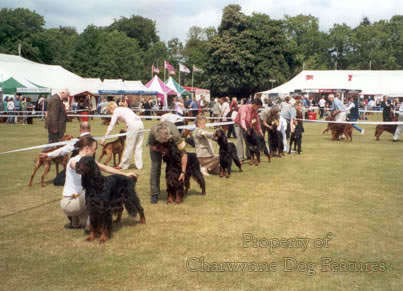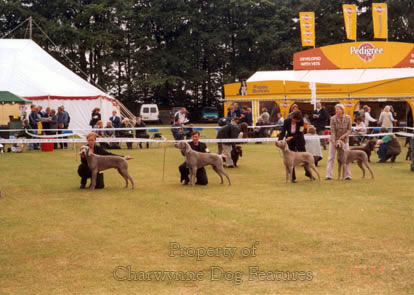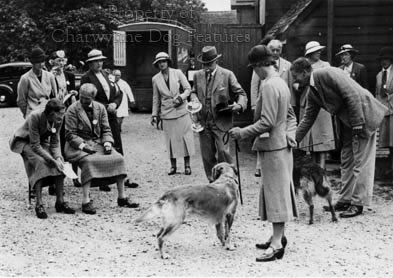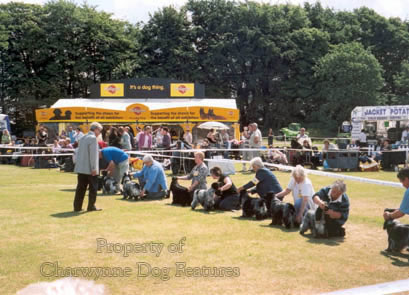40 TODAY'S GUNDOGS - ARE THEY SOUND
TODAY'S GUNDOGS - are they sound?
by David Hancock
 “We would therefore advise the discerning reader to attend these exhibitions – not to walk round when the dogs are benched, but to make a point of being present at the judging, to plant himself stolidly down opposite the ring, and to scrutinize carefully every animal in it…he will then appreciate what a heavy-loaded shoulder, slack loins, or bad feet mean in hard day’s work. This is by no means learnt in a day, though some people have an instinctive eye for the points of an animal.”
“We would therefore advise the discerning reader to attend these exhibitions – not to walk round when the dogs are benched, but to make a point of being present at the judging, to plant himself stolidly down opposite the ring, and to scrutinize carefully every animal in it…he will then appreciate what a heavy-loaded shoulder, slack loins, or bad feet mean in hard day’s work. This is by no means learnt in a day, though some people have an instinctive eye for the points of an animal.”
From The Keeper’s Book by Sir Peter Jeffrey Mackie, Foulis & Co., 1924.
Show Stock Appraisal
If you are aware of how our gundog breeds evolved, prize our gundog breeds and have an interest in seeing them perpetuated in their classic mould, then, even if you don't show dogs, it pays to visit a conformation dog show for them from time to time. I would recommend an outdoor show; the dogs enjoy it more and the setting is far more appropriate. For as long as sixty years, I have been visiting the Bath Dog Show, now held in an attractive rural setting at Bannerdown, between Bath and the M4 motorway. I believe that this location, thanks to the vision of Labrador breeder Geoff Waring and his wife, is now owned by the Bath Canine Society. I first attended as a mid-teens kennel-boy to a Bath vet, who was also the show vet, in the late 1940s. I have long been appreciative of the instruction I received on breed-points and the conformation of the dog whilst touring such a show with my employer vet and his fellow Bath vet, Manson Baird, the Deerhound breeder. The 2007 gundog entry at their old show would have disappointed them. (Since then, I have seen some of this entry’s offspring – and their offspring.)
Sadly the foreign gundog breeds were more impressive than our native ones, although the Weimaraners ranged from oversized specimens to distinct weeds. The Brittanys I admired; the German pointers looked the fittest, especially the wire-hairs; the Spinoni lacked muscular development, which gives any sizeable dog very ugly movement. The Vizslas varied undesirably, some over-boned, some too fragile, with wide variations too in the movement, perhaps because many were stiff-hocked, some were loose in the shoulder and a few were lacking coordination on the move. This can come from a mis-match between the fore and hindquarters, with weakness at the back making the dog pull itself along. It should always be a joy to see a sporting breed moving, without effort, using that appealing slingy action, with real spring in the step, feet hardly leaving the ground, shoulders moving freely and genuine power coming through from the rear. The absence of this in some of our native gundog breeds on display made dismal viewing.
I don't think I've ever seen so many poor setters in one place, Irish Setters especially. This is such a handsome breed, and when soundly constructed and in top condition, is a joy to observe. The distinctive coat saved some of them from being Salukis! But then some of the Pointers on display resembled dish-faced Greyhounds. The clear lack of muscular development made me wonder if these dogs ever got exercised. The slab-sidedness made me wonder if their breeders themselves had ever strode out across a moor and experienced the lung-power needed for sustained field work. Today's Pointers are Whippets compared to their ancestors, which were much more hound-like and strongly-made. But an even more worrying feature in the Pointers and setter breeds was the presence of upright shoulders. What was truly depressing was to witness dogs being awarded cards with such a handicap. A front action like a carriage horse is not a pretty sight in bird-dog breeds once revered the world over for their stamina.
Encouraging Signs
The spaniels however cheered me up! There were some excellent Cockers, English Springers and a couple of high-class Welsh Springers. It was so good to see minor spaniel breeds, like the admirable Field, the bustling Sussex, the distinctive Irish Water and the handsome Clumber, although I'll never get used to seeing a sporting spaniel at the weight of the show Clumber. The only gundog I saw struggling with the heat was a heavily-skirted American Cocker Spaniel; I really would not wish to take one home after a long day in the mud! I wonder too about the wisdom of breeding a dog with such a deep and abrupt 'stop'; it has never been anything other than a man-imposed feature and I know of no vet who favours it. Does a gundog actually need such a feature? Is it a benefit or a disadvantage? If it is desirable, why does no other gundog breed gain from it?
The retrievers have long been my favourite gundogs, their popularity is richly deserved but that has its downside. There are some top-class retriever breeders in Britain but the widespread appeal of Labs and Goldies has diluted the quality. A modest retriever breed like the Curly-coat and a workmanlike one like the Chessy always seem undervalued by the public. Such under-rated breeds need our support and would benefit from greater field use. At this show there were some disappointing Flatcoats, a whole ring full of over-coated Goldens and several rings full of overweight Labs. Sportsmen may not be surprised by this but many country dwelling gundog fanciers unacquainted with working stock buy their pet gundogs from kennels willing, it seems, to show off their flawed dogs to the world in this way; what ever happened to 'show condition', or, for that matter, owner-pride?
Sustained Criticism
Thinking I might have been over-critical, a day or so after the show I went into my archives and consulted the critiques of the gundog judges at Crufts in recent years. The Kennel Club boasts that here you find the best of the very best; what did their appointed judges report? Here are some judgements: Crufts 2004, Weimaraners - "...so many of the dogs were in soft condition and lacked muscle tone...short steep upper arms were the norm". Flat-coats - "We still have too many upright shoulders, short straight steep upper arms...Mouths are another big problem..." IWS - "I found too many short necks, upright shoulders..." Sussex Spaniels - "How do some exhibits get past judges?" American Cockers - "I was dismayed to find so many poor fronts..."
These are the dogs that would have been the parents of the exhibits I saw in 2007; their faults are being perpetuated. If Crufts is reckoned to be the place to find excellence, the judges seem to have difficulty in doing so. Crufts 2005, Flatcoats - "...bad mouths and poor construction were only too evident..." Welsh Springers - "Movement varied from being correct and positive to downright unsound. This is due almost entirely to bad construction. Short upper arms, no depth of chest..." Crufts 2006, Clumbers - "Truly I was disappointed by the number of unsound exhibits..." Labrador dogs - "I was appalled at what some people had qualified..." In other words, there were dogs at Crufts without quality. After the 2007 show, judges in five gundog breeds reported poor movement. Many of these exhibits have been bred from and their faults passed on. Later in this section I have spelt out some of these potentially pernicious flaws cropping up in succeeding litters.
Persistent Faults
It’s worrying to read of certain faults persisting in some gundog breeds down the years. The great Flat-coat breeder, H Reginald Cooke was writing in The Kennel Gazette of December 1908: “…I think more attention should be given to neck and shoulders. Though much improvement has been made, one still sees too many dogs with short necks and straight shoulders.” A century later and the Crufts judge for the breed is concerned about the entry stating that they ‘need to have a good reach of neck sloping into well-placed shoulders’, expressing considerable worry about the front movement in the younger classes. Show judges in this breed have reported several times in the past few years their concern over upright shoulders and short upper arms in the breed. The front assembly of a retriever is an essential element in its ability to retrieve sizeable game over a long period on a hot day in difficult country; it is not merely a show point for faddists.
Sporting dogs, gundogs especially, the Setter breeds and the Pointer in particular, were once famed for their lung power; now they are uniformly slab-sided in the chest, despite the evidence that such a structure enhances the likelihood of bloat. A Cocker Spaniel can, it appears win Best-in-Show at Crufts with ears that defy the breed standard. The gundog breeds carry surprisingly heavy items of shot game in their mouths using their temporal muscles ahead of their masseter muscle. This results in a soft mouth. Marked cheek development is undesirable in any gundog breed if the soft-mouthed virtue is to be retained. But I see many Labradors with the head and cheek muscles of a Rottweiler. I doubt very much if such a Retriever also displays a soft mouth. I worry too about some gundog breeds beginning to feature too deep a stop; cleft palates and very deep stops all so often go together. Why seek a feature that can harm the dog?
Fit for Function?
The Crufts judge of Labrador bitches at the 2000 show concluded that: "I had two overall concerns...excess weight and movement...Some promising bitches spoilt their chances by moving close behind or were pinning in front." The KC claims that this show contains 'the best of the very best' in each breed exhibited. For Labradors at this premier show to be overweight and display faulty movement is alarming. At this same show, the judge of the Labrador dogs (ie males) observed: "I had a few heads resembling Pyreneans (i.e. Mountain Dogs) rather than Labradors, on the move there were feet coming towards me that were more like lily-pads and shoulders that made me despair. The latter point not being helped by excess weight..." If these are the top dogs in this breed in the show world, what are the rest like?
Working Ability
It is depressing however for any admirer of dogs that can work to read a prominent KC member declare a few years back that people don't want their terriers to go to ground, their Border Collies to herd sheep or their gundogs to retrieve game, they just want pets. What a betrayal of trust, an admission of defeat! A breed that is not physically able to carry out its original task has no right to bear the name of that breed. It is not a question of whether it has to but whether it is able to undertake its historic role, indeed, whether it is truly a member of that historic breed at all. Do we really want retrievers with no capability for retrieving?
Working Anatomy
In his timeless textbook on gundogs: The Early Life and Training of a Gundog of 1931, the eminent trainer of that period, Lt Col GH Badcock wrote: “No animal can move without propelling power, and that comes first from the loins, which should be broad and strong; secondly from the shape of the pelvis, which Nature in her wisdom has built in the galloping dog in the form of a crouch, and the more this is intensified the better the propelling power. The last bit of mechanism to fit in with propulsion is the hock, to me the most wonderful joint of all to dissect and examine. Very truly did old Jorrocks remark: ‘No fut, no ‘oss; no ‘ock, no ‘unter.’” Show ring judges today can become obsessed by the angle at the hock but not many test the strength of the exhibit’s loin.
Crufts as a Livestock Show
Of course, there are some excellent gundogs at Crufts and there are excellent breeders of dual-purpose gundogs too. What we need to do is reject from the show ring, not even allow them to be exhibited, dogs with the kind of structural flaws highlighted by the top show ring judges themselves. It’s not good enough for them just to go cardless; they should thrown out of the ring, before the judging even starts. A dog show is a livestock show or it is nothing. Dogs that qualify for Crufts with blatant faults represent a severe judgement on the show ring judges who provided them with qualification. In the wake of that admirable TV programme Pedigree Dogs Exposed, quite remarkable changes are being made in the show dog world. After the sad and predictable attempts to ‘shoot the messenger’ rather than heed the message, immediately after that hard-hitting programme, the Kennel Club has grasped the nettle over such serious matters as excessive exaggeration in many breeds and I give them credit for that.
Commendably, the Kennel Club is at last striving to perpetuate a working anatomy on its entry; they ask for fitness for function, they ask for gundog judges to attend field trials. Over the last century the KC has not done all it could to perpetuate the working capabilities of the revered breeds of pedigree dog entrusted to its custodianship. Gundogs were developed over many centuries by dedicated master-breeders to perform to a high standard in the field; to be worthy of the responsibility now entrusted to our generation, we simply have to perpetuate these breeds in their time-honoured mould. Many superb working dogs make excellent pets. All dogs kept as pets are spiritually happier if their instinctive behaviour is exercised.
Registry Control
The KC studbook should never merely be a register of births but a record of sound stock. How else can dog owners wishing to own purebred animals be given a service for their registration fee? A livestock studbook has to be much more than a breeding record; domestic animals are not free to choose their mates. We cannot elect to do that for them unless we act responsibly. Breeders of working gundogs are protected in many ways by the performance of their stock; their brand’s reputation is their sales pitch. The general public seeking a gundog as a companion dog is at the mercy of breeders, breeders that really do need pressure to breed sound typical healthy dogs and that pressure can only come from the body registering the breeders’ stock as healthy. A breed’s popularity should instill greater quality control in breeders not just the need to produce puppies.
Fickleness of Fashion
Today’s favourite breed can so easily become tomorrow’s victim breed. And gundogs are too precious for us to allow them to become such victims without a fight. Fashion is fickle and breeds can suffer cruelly from it. If you look at the advertisements in the sporting press for gundog pups from the highly popular breeds, most are from parents neither hip scored nor eye-tested. If only the public would insist on health screening for their prospective purchases; it would put an important new dimension into breeding plans. I have seen puppies advertised at high fees without the high hip score of their dam or sire being stated during subsequent enquiries. Hip dysplasia is a complex disability but inheritance is a major factor. It is surely of paramount importance for working dogs of any breed to be clear of potentially crippling disabilities.
The Best of the Very Best
The KC’s slogan for Crufts for many years has been to describe the entry as ‘the best of the very best’. Undoubtedly there are good dogs there; but what are the judges, alleged to be the best too, saying? Here are some judges’ comments on the gundog entry of 2012: Flat-coated Retriever bitches: “I am however concerned that some exhibits in the lower classes were very slight, lacking in bone, which is required to carry out a day in the field, also front movement was poor due to incorrect upper arm and lay of shoulder.” Irish Setters: “I did find quite a lot of upright shoulders which we must all look out for.” English Setters: “I do feel that some breeders are not paying enough attention to this (i.e. correct anatomy for speed and endurance) and consequently we are seeing dogs which are weak in those aspects – some with a lack of angulation, some with elbows turning out and feet turning in, some with sickle hocks, etc., all of which contributes to a lack of forward reach and rear drive, thereby causing them to tire more quickly…more noticeable in the dogs.” Pointers: “I think that front angulation is still a problem, we are seeing brisket well above the elbows, short necks, no extension in front on the move and we are seeing more over-angulation in the hindquarters.” Irish Red and White Setters: “There were several exhibits with flat splayed feet and weak pasterns…” At Crufts! Of course, the judges had great praise for most of the exhibits but gundogs that qualify for Crufts get bred from, and with these basic faults, that is of some concern.
It is lazy thinking to argue that sportsmen know where to get a good gundog, so what's the problem. Our famous gundog breeds deserve the loyal support of knowledgeable dogmen and should not be abandoned to show ring incompetents. Of course there are really good British gundog breeders, quite capable of producing outstanding dogs. But what about the mainstream system for perpetuating the gundog breeds, our native gundog breeds especially? I saw better Flatcoats in Finland a few years ago than those at the Bath show. But their breeding system and judging method is so superior to ours; it clearly produces better dogs. And so we muddle on, with the Kennel Club boasting about the sheer quality of the dogs on parade at Crufts, despite what their own judges are saying. Perhaps every gundog breed needs to mirror the work of the Working Clumber people, the satisfaction of seeing a working anatomy restored in so many breeds would surely delight the heart of any true gundog devotee. Show breeders are often accused of favouring flashiness ahead of soundness and if that is true, breed clubs and especially breed councils just have to redress this. It’s vital for today’s breeders to know how their breed was shaped, what decided its form.
“Whether retriever or pointer, we want a level mouth, neither undershot nor overshot – the former condition is almost never seen, but the so-called snipey muzzle is a common defect in our retrievers at the present time, and a bad one…The chief points, therefore, to be desired in a working dog are a good head and eye, light shoulders, strong loins, powerful thighs, and compact feet. Given these in our chosen puppy, and we start well with an animal better than our neighbour’s, while we hope to make him above the average in other respects.”
From The Keeper’s Book by Sir Peter Jeffrey Mackie, Foulis, 1924.